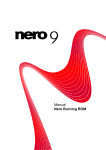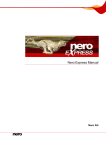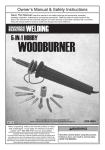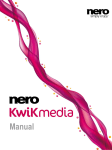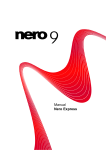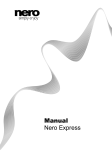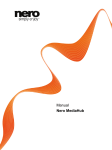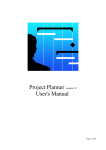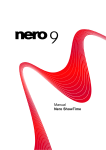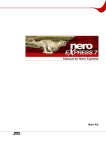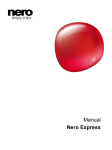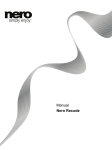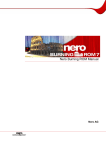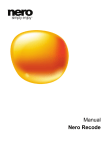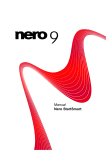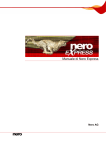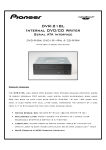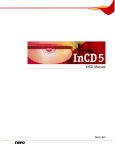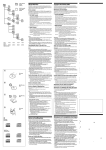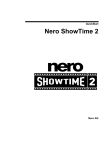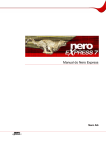Download Manual Nero Express
Transcript
Manual
Nero Express
Copyright and Trademark Information
Copyright and Trademark Information
This document, like the software described therein, is provided as a license and may only be used or reproduced in accordance with
the licensing agreement. The contents of this document, as well as the associated software, is subject to change without prior notice.
Nero AG rejects any responsibility for the correctness of the contents of this document and rejects any claims that transcend the
clauses of the guarantee agreement.
This document and all of its contents are protected by copyright and are the property of Nero AG. All rights reserved. In addition, this
document contains material that is protected by internationally valid copyright. This document may not be reproduced, transmitted, or
transcribed in whole or in part without the express written permission of Nero AG.
Please keep in mind that existing graphics, pictures, videos, music titles or other materials that you may wish to insert or transcribe
into projects may be protected by copyright. The unauthorized use of this type of material in your projects may violate the rights of
the owner of the copyright. Make sure that you obtain all necessary authorizations from the owner of the copyright.
Unless you own the copyright, have permission from the copyright owner or your actions fall under the "fair use" provisions of copyright law, you may be violating national or international copyright laws. The transcribing, re-formation, modification or publication of
copyright-protected material may lead to claims for damages and the enforcement of other legal measures against you. If you are
unsure of your rights, you should contact your legal advisor.
Some Nero Suite applications require technologies developed by third-party manufacturers, some of which are contained in the Nero
Suite as demo versions. These applications can be activated online free of charge or by sending an activation fax to have unlimited
use of the version. Nero will only transmit the data necessary for activation of the technology licensed from third parties. For unlimited use of Nero Suite, it is therefore necessary to have an Internet connection or a fax machine.
Copyright © 2006-2008 Nero AG and its licensors. All rights reserved.
Nero, the Nero logo, Nero Digital, Nero Essentials, Nero Express, Nero ImageDrive, Nero LiquidTV, Nero MediaHome, Nero PhotoSnap, Nero Recode, Nero RescueAgent, Nero ShowTime, Nero SecurDisc, Nero StartSmart, Nero Vision, InCD, Move it, and UltraBuffer are brands or protected trademarks of Nero AG.
Gracenote® is either a registered trademark or a trademark of Gracenote, Inc. in the United States
and/or other countries. The Gracenote logo and logotype, and the "Powered by Gracenote" logo
are trademarks of Gracenote.
Adobe, Acrobat, Acrobat Reader and Premiere are brands or protected trade names of Adobe Systems, Incorporated.
AMD Athlon, AMD Opteron, AMD Sempron, AMD Turion, ATI Catalyst and ATI Radeon are brands or registered trademarks of Advanced Micro Devices, Inc.
ATSC is a brand of the Advanced Television Committee.
ICQ is a registered trademark of AOL, LLC.
Apple, iPhoto, iPod, iTunes, iPhone, FireWire, and Mac are brands or registered trade names of Apple, Inc.
ARM is a registered trademark of ARM, Ltd.
AudibleReady is a registered trademark of Audible, Inc.
BenQ is a brand of the BenQ Corporation.
Blu-ray Disc is a brand of Blu-ray Disc Association.
CyberLink is a registered trademark of CyberLink Corp.
DLNA is a registered trademark of Digital Living Network Alliance.
DivX and DivX Certified are registered trademarks of DivX, Inc.
Dolby, Pro Logic and the double-D symbol are brands or registered trademarks of Dolby Laboratories, Inc.
DTS and DTS Digital Surround are registered trademarks of DTS, Inc.
DVB is a registered trademark of the DVB Project.
Freescale is a brand of Freescale Semiconductor, Inc.
Google and YouTube are brands of Google, Inc.
WinTV is a registered trademark of Hauppauge Computer Works, Inc.
Intel, Intel XScale, Pentium and Core are brands or registered trademarks of Intel Corporation.
Linux is a registered trademark of Linus Torvalds.
Memorex is a registered trademark of Memorex Products, Inc.
ActiveX, ActiveSync, DirectX, DirectShow, Internet Explorer, Microsoft, HDI, MSN, Outlook, Windows, Windows Mobile, Windows
NT, Windows Server, Windows Vista, Windows Media, Xbox, Xbox 360, the Windows Vista start button and the Windows logo are
brands or registered trademarks of Microsoft Corporation.
My Space is a brand of MySpace, Inc.
NVIDIA, GeForce and ForceWare are brands or registered trademarks of NVIDIA Corporation.
Nokia is a registered trademark of Nokia Corporation.
CompactFlash is a registered trademark of SanDisk Corporation.
Sony, Memory Stick, PlayStation, PLAYSTATION and PSP are brands or registered trademarks of Sony Corporation.
HDV is a brand of Sony Corporation and Victor Company of Japan, Limited (JVC).
UPnP is a registered trademark of the UPnP Implementers Corporation.
Labelflash is a registered trademark of Yamaha Corporation.
The trademarks mentioned here are named for information purposes only. All trade names and trademarks are the property of their
respective owners.
Nero AG, Im Stoeckmaedle 13-15, D-76307 Karlsbad, Germany
Nero Express
Table of contents
Table of contents
1
1.1
1.2
1.3
Start Successfully
About the manual
About Nero Express
Working with Nero Express
5
5
5
6
2
Launching the program
7
3
3.1
Start screen
Extended area (start screen)
8
9
4
Compilation screen
11
5
5.1
5.2
5.3
Data Disc
Compiling data CDs/DVDs
Enabling SecurDisc settings
Saving Data Tracks
13
13
15
18
6
6.1
6.1.1
6.2
6.3
6.4
6.4.1
6.5
6.5.1
Music
Compiling Audio CDs
Customizing properties of the audio file
Compiling jukebox disc
Compiling an audio book CD
Automatic Music Recognition
Identifying Audio Files
Copy Audio CDs to Hard Drive
Copy Audio CDs to Hard Drive
20
20
21
25
25
26
26
27
30
7
7.1
7.1.1
7.2
Video and Slide Show
Compiling Video CDs/Super Video CDs
Customizing the menu
Compiling DVD-Videos
34
34
36
36
8
Loading a disc image or saved project
38
9
9.1
9.2
9.3
LightScribe
Printing LightScribe labels (without compilation)
LightScribe Print Properties window
Printing LightScribe labels (within the project)
39
39
41
42
10
10.1
10.2
Labelflash
Burn Label screen
Printing Labelflash labels and DiskT@2
44
44
45
11
11.1
11.2
Burn Compilation
Choice of recorder
Start the burn process - Burning discs with the drive
48
48
49
Nero Express
III
Table of contents
11.3
11.3.1
11.4
Final Burn Settings screen
Extended area (Burn Settings)
Burning with Nero Image Recorder – Creating an image file
50
51
52
12
12.1
12.1.1
12.1.2
12.2
12.3
Copying CDs/DVDs
Copying methods
On-the-fly
Copy image
Copying CDs/DVDs
Copy settings
54
54
54
54
55
57
13
Erase Rewritable Disc window
59
14
Final screen
61
15
15.1
15.2
15.3
15.4
15.5
Configuration options
Settings for the compilation
Cache settings
Expert Features
Ultrabuffer settings
LightScribe settings
62
63
63
64
64
65
16
16.1
16.2
16.2.1
16.2.2
16.2.3
16.2.4
16.2.5
16.2.6
16.2.7
16.3
Technical Information
System requirements
Formats supported
Disk types
Disc formats
Audio formats and codecs
Metadata
Video formats and codecs
Image formats
Formats for Playlists
Versions of Nero Express
66
66
66
66
66
67
67
68
68
68
68
17
Glossary
70
18
Index
74
19
Contact
76
Nero Express
IV
Start Successfully
1
Start Successfully
1.1
About the manual
This manual is intended for all users who want to learn how to use Nero Express. It is process-based and explains how to achieve a specific objective on a step-by-step basis.
To make best use of this documentation, please note the following conventions:
Indicates warnings, preconditions or instructions that have to be precisely followed.
Indicates additional information or advice.
1. Start …
The number at the beginning of a line indicates a prompt for action.
Carry out these actions in the order specified.
Indicates an intermediate result.
Indicates a result.
1.2
OK
Indicates text passages or buttons that appear in the program interface. They are shown in boldface.
(see…)
Indicates references to other chapters. They are executed as links
and are shown in red and underlined.
[…]
Indicates keyboard shortcuts for entering commands.
About Nero Express
Nero Express provides all the performance and efficiency of Nero Burning ROM with a simplified user interface. Whether you are a beginner or an expert, Nero Express guides you
quickly and easily through your desired burning tasks. The default settings are selected to
automatically produce the best possible results. Using the program is remarkably easy: simply select the project to be burned, add the files, and start burning.
It is just as easy to create Nero Express discs with SecurDisc and a SecurDisc supported
drive. SecurDisc is a new hardware and software technology developed by Nero and HLDS
with which you can create discs with special protection properties, such as data integrity, reconstructability, encryption and duplication protection. Such discs can be created with SecurDisc supported drives (e.g. from HLDS/LG and Nero Express) and read from any drive
with InCD or InCD Reader.
Nero Express
5
Start Successfully
1.3
Working with Nero Express
Basically, the user interface of Nero Express consists of the selection of a compilation method in the start screen. You then complete the task by navigating through the different steps
where a separate window is displayed for each individual step. This generally requires four
steps:
Choose compilation type
Select what you would like to do by moving the cursor over the menu item and clicking one
of the tasks displayed. This manual contains a chapter for each task that describes all of the
steps required for its completion.
Completing a task
Depending on the task, you will have to go through various steps until you reach the end.
Each individual step consists of a new screen. For each screen, the manual contains a chapter in which all areas are described in detail.
Burning a Compilation
Burning marks the end. To do this, set the burn parameters and click the Burn button. Depending on the type of the task you are working on and the recorder connected to the system, a number of different entries are available for selection.
Options after burning
After burning is complete, you can decide what to do next: select the option to continue
working with Nero Express or exit the program.
Nero Express
6
Launching the program
2
Launching the program
To start Nero Express via Nero StartSmart, proceed as follows:
1. Click the StartSmart icon.
The Nero StartSmart window opens.
2. Click the
button.
The list of Nero applications appears.
Nero StartSmart window
3. Select the Nero Express entry in the selection list.
4. The Nero Express window opens.
You have launched Nero Express via Nero StartSmart.
Nero Express
7
Start screen
3
Start screen
The main screen in Nero Express is the starting point for all actions. Click here on the relevant menu icons to go to the desired screen where you can compile and work on your project. The selection is categorized into two areas: several formats or options are available for
the Data, Music, Videos/Pictures, Image, Project, Copy and Print LightScribe Label
compilation methods.
Click the
button in the left margin of the window to display an extended area with addi-
tional options and features.
Nero Express Start Screen
The following compilation methods are available:
Data
Allows you to compile and burn all types of files and folders:
Music
Allows you to compile and burn audio and audio book files in the formats you want:
Videos/Pictures
Allows you to compile and burn video and/or picture files as
VCD/SVCD or DVD-Video:
Image, Project,
Copy
Allows you to copy a source disc and to load an image file or a saved
project:
Print LightScribe Label
Displays the Disc Label screen.
This is where you can create or load a label in order to print on the label side of special CDs/DVDs in the recorder.
A LightScribe recorder must be selected to enable the option.
Nero Express
8
Start screen
The actual entries that are available, and the actual disc types (e.g. DVD) that
can be written to depend on the recorder used.
You can find more information on Blu-ray support at
www.nero.com/link.php?topic_id=416.
See also:
Loading a disc image or saved project 38
LightScribe 39
Labelflash 44
Enabling SecurDisc settings 15
3.1
Extended area (start screen)
You can access the additional options and features in the extended area of the start screen
by clicking on the
button in the left margin of the window. The extended area is available
in all Nero Express screens.
The following menu icons are available:
Switch to Nero
Burning ROM
Closes Nero Express and opens the start screen of Nero Burning
ROM.
This option is only available in the extended area of the start
screen. If you decide to create a project with Nero Express, the option Saves the active project is displayed in all of the other windows at this point.
Saves the active
project
Opens the Save As... window to save your compilation. The file
links and settings to be burned are saved.
Options
Opens the Options window to customize Nero Express to suit your
requirements.
Copy Audio CD
Tracks
Opens the Copy Audio CDs to Hard Drive to copy audio files from
CD to the hard drive.
Copy Data Track
Opens the Select Track window in which you can save the track of
a data disc as an image file.
Erasing a Disc
Opens the Erase Rewritable Disc window to erase data from a rewritable CD/DVD.
Disc Info
Opens the Disc Info window to display information about the inserted CD/DVD. The total capacity and available capacity are displayed, in addition to the tracks and sessions.
Nero Express
9
Start screen
Create Covers and
Labels
Opens Nero CoverDesigner. Nero CoverDesigner is used to create
and print labels and booklets for burned CDs/DVDs.
Please see the separate Nero CoverDesigner user manual for full
instructions on how to make professional looking covers and labels.
SecurDisc Settings
Defines the settings for burning a SecurDisc disc.
Burn Label
Opens the Burn Label window, in which you can create or load a
label in order to print a label and/or print directly on the data side of
special CDs/DVDs in the recorder.
Available with a Labelflash™ recorder only. The recorder must be
selected to enable the option.
Recorder
Defines the recorder that you want to use for burning and/or the Nero Image Recorder.
See also:
Configuration options 62
Copy Audio CDs to Hard Drive 30
Erase Rewritable Disc window 59
Nero Express
10
Compilation screen
4
Compilation screen
You can access the Nero Express compilation screens by selecting the compilation method
you want in the start screen. You can add data to your projects in the compilation screens
and customize the directory structure on the CD/DVD to suit your requirements. The capacity
bar near the bottom of the window indicates how much space is being used by the data on
the CD/DVD. Essentially, all compilation screens have the same structure.
Compilation screen
The following setting options are available in the compilation screen:
Button
Opens the Add files and folders window.
Add
Button
Removes the selected file.
Delete
Button
Plays a selected audio or video file.
Playback
Button
Returns to the start screen.
Back
Button
Switches to the Final Burn Settings screen.
Next
Button
Properties
Opens the Audio Track Properties dialog box for Audio CDs
and the MPEG Information dialog box for video CDs/SuperVideo-CDs.
Available for audio, video, and Super Video CDs only.
Nero Express
11
Compilation screen
Check box
Enables a menu for the CD.
Enable VCD Menu
You can customize the look of the menu to suit your requirements.
Available for video and Super Video CDs only.
Check box
Enables a filter that brings the volume of the audio files to be burned into line with one another. This is recommended particularly if
the files originate from different sources.
Available for Audio CDs only.
Normalize all audio
files
Check box
No pause between
tracks
Selection list
DVD9(8152MB) /
DVD5(4483MB)
Establishes that the audio files merge into one another without a
pause. If the box is unchecked, a pause of two seconds is inserted between the files.
Available for Audio CDs only.
If the DVD recorder is capable of burning DVDs with 2 layers
(DVD DL), and if you want to burn files larger than 4483 MB, you
can select the DVD9 (8152 MB) option from the drop-down menu.
Available for DVD-Videos only.
You can find more information on Blu-ray support at
www.nero.com/link.php?topic_id=416.
See also:
Settings for the compilation 63
Nero Express
12
Data Disc
5
Data Disc
5.1
Compiling data CDs/DVDs
Using Nero Express you can compile and burn all types of files and folders. If a DVD recorder is installed on your computer, you can burn both data CDs, and data DVDs. If you
have a CD recorder, you can only burn data CDs and the option for burning a DVD is already
grayed out in the start screen. The procedure for both compilation methods is identical.
SecurDisc recorder
If a SecurDisc recorder is installed on your computer, you can select it to display the relevant entry in order to burn a SecurDisc CD or DVD. The procedures for both adding data and burning a SecurDisc data CD/DVD are the
same as the compilation method for a standard data CD/DVD..
The Image Recorder is also suitable for creating an image of a disc type not
supported by the connected recorder. You can therefore create a DVD image,
for instance, without having installed a DVD recorder. You can write the image
to a disc at any time.
You can find more information on Blu-ray support at
www.nero.com/link.php?topic_id=416.
To create a data CD/DVD, proceed as follows:
1. Click the Data menu icon in the Nero Express start screen.
The Data CD and Data DVD options are displayed.
2. Click the option you want.
The Disc Content compilation screen for data CDs/DVDs is displayed.
If you selected one of the SecurDisc Data CD or SecurDisc Data DVD options in the
start screen, an additional dialog box opens.
Additional options are displayed in the extended area of the compilation window under
SecurDisc Settings.
Nero Express
13
Data Disc
Disc Content compilation screen
3. Click the Add button.
The Add files and folders window opens.
Add files and folders window
4. Select the files that you want to add to the compilation and click the Add button.
5. Repeat the previous step for all files that you want to add.
Nero Express
14
Data Disc
6. Click the Close button.
The files are added to the compilation and displayed in the compilation screen.
7. Hide specific files.
8. If you want to create a SecurDisc data CD/DVD, select the desired check boxes in the SecurDisc Settings area.
9. Click the Next button.
If you have checked boxes in the SecurDisc Settings area, the corresponding dialog
boxes will be opened and you will be able to make more settings.
You have successfully compiled a data CD/DVD and can now burn this compilation.
See also:
Compilation screen 11
Enabling SecurDisc settings 15
5.2
Enabling SecurDisc settings
To be able to view copy-protected files, you will need a special application called SecurDisc Viewer, which can be downloaded free of charge at
www.securedisc.net.
The Copyright feature is only available for SecurDisc Data DVD.
To protect the data on your SecurDisc CD/DVD from unauthorized access with a password,
to protect PDF files with duplication protection, to remove duplication protection by entering a
password, or to sign the disc with a digital signature, proceed as follows:
1. Select the Password protection check box in the extended area of the compilation screen.
A lock symbol shows that all data is protected.
2. To disable or selectively enable the protection feature for individual files:
1. Highlight the required file to display the Unprotect/ Protect button.
2. Click the Unprotect/Protect button to enable or disable protection.
The protection feature is enabled or disabled for the selected file.
3. Select the Digital signature check box in the extended area of the compilation screen.
The SecurDisc – Digital Signature dialog box opens.
Nero Express
15
Data Disc
SecurDisc - Digital Signature window
4. If you have already created a digital key:
1. Click the Browse button.
The SecurDisc – Select Private Keys dialog box opens.
2. Select the key and click the OK button.
5. To create a digital key:
1. Click the Start button.
The SecurDisc – Create Digital Key dialog box opens.
2. Read the instructions and click the Next button.
The SecurDisc Key Creation Process dialog box opens.
3. Move your mouse at random until the creation process is complete.
You can monitor the status of the creation process using the progress bar. The Next
button is enabled as soon as the process is complete.
4. Click the Next button.
The SecurDisc – Key Setting Ended dialog box opens.
5. Enter a file name for the key you have created and click the Finish button.
The SecurDisc – Digital Signature dialog box opens and the selected key is displayed in the drop-down menu.
Nero Express
16
Data Disc
6. Select the Copy protection check box in the extended area of the compilation screen.
All PDF files are copy-protected. The check box Use password to disable copy protection appears.
7. To permit duplication of the copy-protected data after entering a password:
1. Select the Use password to disable copy protection check box.
The SecurDisc – Protect Data dialog box opens.
2. Enter the desired password in the Password input area and then click the OK button.
8. Click the OK button.
The corresponding dialog box will open to inform you that the disc is being digitally
signed with the selected key.
You can pass on the relevant public key to recipients to enable them to verify
the signature.
9. Click the OK button.
10. Click the Next button.
The SecurDisc – Protect Data dialog box opens.
SecurDisc – Protect Data window
Nero Express
17
Data Disc
11. Enter the desired password in the Password input area and then click the OK button.
When appropriate, a wizard offers suggestions in an additional Tips dialog box
when entering and selecting the password. The wizard estimates the security
level, i.e. the quality of the password, during entry.
You have now protected the data on your SecurDisc CD/DVD against unauthorized access by assigning a password, protected PDF documents with duplication protection,
and/or digitally signed the disc. Now you can burn the CD/DVD.
5.3
Saving Data Tracks
With Nero Express you can save a data disc as an image file. The image file can later be
burned to a recordable disc. The result is a copy of the original data disc.
To save the data disc as an image file, proceed as follows:
1. Insert the data disc in a drive.
2. Click the Save Data Tracks button in the extended area of the start screen.
The Select Track window opens. The tracklist shows you the sessions and data tracks
that are found on the disc. Due to the technical reasons, only the first data track of the
first session can be saved.
Select Track
3. Select the first data track.
4. Click the Save Track button.
The Save As window opens.
Nero Express
18
Data Disc
5. Select a file name and a storage location.
6. In the Save As drop-down menu, select the desired output format (ISO or NRG) for the image file.
7. Click the Start button.
The Progress window is opened and displays the progress made while saving. When
the save process is complete, the window closes automatically.
You have successfully created an image file starting from a data disc. Now you can burn
the image file to a disc.
Nero Express
19
Music
6
Music
6.1
Compiling Audio CDs
Using Nero Express you can create an Audio CD that contains music files. It can be played
using all standard CD players. To compile an Audio CD, source files with different audio formats (e.g. MP4, MP3 or WMA) are automatically converted into Audio CD format before being burned.
Please not that some CD players cannot play CD-RWs. Use CD-R discs to burn
Audio CDs.
To create an Audio CD, proceed as follows:
1. Click the Music menu icon in the Nero Express start screen.
The compilation methods for music are displayed.
2. Click Audio CD.
The My Audio CD compilation screen for Audio CDs appears.
My Audio CD compilation screen
3. Click the Add button.
The Add files and folders window opens.
4. Select the audio files that you want to add to the compilation and click the Add button.
5. Repeat the previous step for all audio files that you want to add.
6. Click the Close button.
The audio files are added to the compilation and displayed in the compilation screen.
Nero Express
20
Music
7. Customize the properties of the audio files to suit your requirements.
8. Select the Normalize all audio files and No pause between tracks check boxes as required.
9. Click the Next button.
You have successfully compiled an Audio CD and can now burn this compilation.
See also:
Compilation screen 11
Copy Audio CDs to Hard Drive 30
6.1.1 Customizing properties of the audio file
You can display and/or make changes to the audio file properties on the Track Properties,
Indexes, Limits, Splits and Filters tabs of the Audio Track Properties window. To open
the window, select an audio file in the compilation screen My Audio CD for Audio CDs and
click the Properties button.
6.1.1.1
Track properties
On the Track Properties tab you will find basic information on the selected file in the Source information area.
Track Properties Tab
Nero Express
21
Music
The following input areas are available in the Properties area:
Input field
Title (CD TEXT)
Input field
Artist (CD TEXT)
Input field
Pause
Input field
International
Standard Recording Code
(ISRC)
Check box
Defines a title which is saved as CD text.
CD players that support CD Text show the title name entered here.
Defines the artist which is saved as CD Text.
CD players that support CD Text show the artist's name entered here.
Defines the length of the pause in seconds or frames between the
selected audio file and the next one.
Identifies the CD title using a 12-character digital code. The ISRC is
entered in the subcode and included silently.
If you do not know the ISRC, you should leave this input field blank.
Enables copy protection.
Copy protection
Check box
Cross fade with
previous track
6.1.1.2
Defines a crossfade between this and the previous audio file. You
can specify the length of the crossfade in seconds or in sectors.
Indexes, Limits, Split
On the Indexes, Limits, Split tab you can set and delete indexes and split audio files to create two or more shorter ones. The tab consists of the Oscilloscope and Positions. areas.
Indexes, Limits, Split Tab
Nero Express
22
Music
Audio files are displayed graphically in the Oscilloscope area. The following configuration
options are available in the Positions area:
Selection lists
Start/End
Button
New Index
Button
Shows the positions for the beginning and end of the audio file on
the CD.
Sets a new index position at the selected position. For the CD player this is the position from which a new song starts, and the player
can also jump to it directly. However, not all CD players support this
feature.
Edit
Opens the Set Track End dialog box.
You can enter the exact position of a split.
Button
Deletes a selected index.
Delete
Button
Splits the audio file at the marked position.
Split
Button
Playback
Button
Plays the audio file from the marked position.
During playback, the Stop button is shown.
Stop
Stops playback of the audio file.
If playback is stopped, the Play button appears again.
Button
Splits the audio file at the set index positions.
Split at Index Positions
Button
Enlarges the graphical representation of the audio file.
Zoom In
Button
Reduces the graphical representation of the audio file.
Zoom Out
Button
Displays a graphical representation of the entire audio file.
Full View
6.1.1.3
Filter Settings
The Filters tab includes filters that improve or change the quality of the music. The so-called
non-destructive procedure is used for processing, i.e. the actual recording is not changed,
but flags are simply set that can be canceled at any time. No additional audio data is created. The audio files are not actually changed until they are written.
Nero Express
23
Music
Audio Track Properties window, Filters tab
The following configuration options are available in the Audio Track Properties window:
Check box
Normalize
Check box
Declick
Check box
Hiss Reduction
Check box
Fade In
Check box
Fade Out
Check box
Stereo Widening
Check box
Sets the volume of an audio file to a preset value. This filter can
be useful to bring the volume of files originating from different
sources into line with one another.
Removes clicking and scratching noises, such as those on old
LPs for example.
Reduces or removes the hiss on an audio file. All frequencies below a certain threshold (hiss level) are removed.
Fades in the volume of an audio file from zero to full volume. This
filter can be useful for shortening files.
Fades out the volume of an audio file from full volume to silence.
This filter can be useful for shortening files.
Increases/reduces the stereo effect of an audio file. This filter only
works if the original file was recorded in stereo.
Karaoke
Fades out the vocals on an audio file. This is done by fading out
the parts of a song that are the same in both stereo channels.
Check box
Adds an echo to the audio file.
Echo
Nero Express
24
Music
Check box
Equalizer
Button
Test Selected Filters
Selection list
Normalization method
Selection list
Opens an equalizer so you can change the volume, bass, and
pitch in different frequency ranges.
Plays the audio file and applies the activated filters. During playback, the configuration options for the filters can be changed, allowing the effect to be controlled.
Sets the midpoint of the track to the specified value. Maximum
sets the volume to the greatest value possible without clipping.
Sets a standard value for the volume of a track.
Percent
6.2
Compiling jukebox disc
Nero Express can be used to compile discs with audio formats you require (e.g. Nero Digital,
MP3 or WMA). In contrast to Audio CDs that can only be burned on CDs, you can burn these
compilations of different audio formats on other disc types – provided an corresponding recorder is installed on your computer. The procedure for compilation methods is identical. You
can opt for a single format or a mix of audio formats of your choice.
Nero Express does not convert the audio files when creating a jukebox disc. In
other words, MP3 files are burned as MP3 files for example. Most CD players
cannot play such discs.
There is no difference between creating a jukebox disc and creating an Audio CD. Please be
sure to select the corresponding entry in the start screen.
From a technical point of view, a compilation of special audio formats is a data
CD/DVD. You can also select Nero ExpressData > Data CD/DVD in the start
screen to create and burn your project.
See also:
Compilation screen 11
Compiling data CDs/DVDs 13
6.3
Compiling an audio book CD
Nero Express is used to compile audio book files and burn them as an audio book CD, i.e. in
the form of an Audio CD. You can then play it on any standard CD player. Since audiobooks
can play for several hours, Nero Express saves the audiobook to multiple audio CDs. During
the burn process, you are prompted to insert new blank discs.
The procedure for compiling audio book CDs is basically the same as the procedure for creating an Audio CD.
Nero Express
25
Music
See also:
Compilation screen 11
6.4
Automatic Music Recognition
With Gracenote MusicID Nero Express can identify music files. So called metadata such as
artist, title, and genre are accessed from the Gracenote Media Database and displayed in
Nero Express. The identified metadata is written to the music file and is then available.
Identification is possible for single audio files as well as complete original Audio CDs.
If the metadata of the Audio CD is not yet included in the database then you can enter it and
make it available. The metadata is sent to Gracenote and added into the database.
With Gracenote you can have audio files identified out of any sort of compilation. This is particularly useful when audio files are not named or are only partially named. The metadata
that is made available by Gracenote is used for the compilation and is written into the audio
files. In this way your music collection is correctly tagged with all information.
During the following actions, original Audio CDs can be automatically identified in Nero Express with Gracenote MusicID.
Copying Audio CD
Saving Tracks from the Audio CD to Hard Drive
Music recognition technology and related data are provided by Gracenote®.
Gracenote is the industry standard in music recognition technology and related
content delivery. For more information, please visit www.gracenote.com.
6.4.1 Identifying Audio Files
You can have the added audio files in the music compilations identified with Gracenote and
access metadata such as artist and title from the Gracenote Media Database.
To do this, proceed as follows:
1. Choose the type of compilation to burn a music CD.
The compilation screen appears.
2. Add audio files from the hard drive to the music compilation.
3. Select one or more audio files in the compilation.
4. Right-click to open the context menu.
5. Choose the Get Metadata entry.
The audio files are analyzed and the required information is sent to Gracenote. The Edit
MetaData window opens. The metadata received by Gracenote is displayed in the New
Info area.
Nero Express
26
Music
Edit Metadata window
6. If necessary, edit the metadata, e.g. track number, title, artist, album title, year, and genre.
7. Click the Apply button.
The Edit Metadata window closes.
The metadata is written into the audio file and accordingly shown in Nero Express.
6.5
Copy Audio CDs to Hard Drive
Using Nero Express you can save audio files from an Audio CD on the hard drive. In the
process, the files are encoded, i.e. converted into a format that the computer can read. The
audio file is usually compressed.
The Audio CD can be automatically identified with Gracenote MusicID. So called metadata
such as title, genre, and track title are accessed by the Gracenote Media Database and associated to the tracks. That way you have audio files that are accurately and fully named after the encoding process.
Music recognition technology and related data are provided by Gracenote®.
Gracenote is the industry standard in music recognition technology and related
content delivery. For more information, please visit www.gracenote.com.
Nero Express
27
Music
Audio files from copy-protected Audio CDs cannot be saved.
To save audio files, proceed as follows:
1. Click the Copy Audio CD Tracks button in the extended area of the screen.
The Copy Audio CDs to Hard Drive window opens.
Copy Audio CDs to Hard Drive
2. Insert your Audio CD into a drive.
The disc is analyzed and the required information is sent to Gracenote. If an exact matching entry is found in the Gracenote Media Database then that metadata will be used
and displayed.
If several entries are found, the Matches window opens and the possible metadata records are displayed.
3. Select the metadata record that matches your Audio CD.
4. Click the Send New Data button if none of the metadata records match your Audio CD.
5. The Edit MetaData window opens.
Nero Express
28
Music
Edit Metadata
The Edit MetaData window also opens if no matching entry is found in the database but you want to enter the metadata and make it available.
6. If necessary, edit the metadata (e.g. title, artist, album title, year, genre).
7. Click the Advanced Options button if you want to add additional information.
The Gracenote MusicID Information window, which originates from Gracenote, opens.
After entering the additional information, you have to close this window so that the Edit
MetaData window displays again.
8. Click the Submit Data button.
Changed or new Audio CD metadata is sent to Gracenote and added to the Gracenote
Media Database.
The Edit MetaData window is closed and the information is passed on to the Copy Audio CDs to Hard Drive window.
9. Select the tracks that you want to save on the hard drive.
10. Click the Output tab.
The Output tab is opened.
11. In the File Format drop-down menu, select the target file's audio format.
Nero Express
29
Music
12. Choose a method for creating the file name in the Mode for Creating File Names dropdown menu.
13. Define other settings according to your preferences.
14. Click the Copy button.
Conversion starts. A folder with the name of the album is created inside the desired folder. The audio files are saved in this folder and named according to the method you
chose. Metadata that is identified with Gracenote is written to the audio file.
The Progress window indicates the saving progress. When the save process is complete, this window closes automatically.
15. Click the Close button.
The Copy Audio CDs to Hard Drive window is closed. You have saved your audio files.
6.5.1 Copy Audio CDs to Hard Drive
Define the settings for audio files to be saved on the hard drive in the Copy Audio CDs to
Hard Drive. Open the window in the extended area of the start screen by clicking Save
Tracks.
Copy Audio CDs to Hard Drive - Source
Nero Express
30
Music
The following setting options are available:
Tab
Specifies settings for the source of the audio data.
Source
Tab
Sets output files configuration options.
Output
Button
Starts the copy or save process.
Copy
See also:
Compiling Audio CDs 20
6.5.1.1
Source tab
The Source tab displays the audio files on the Audio CD. The functions of the control buttons correspond to the familiar control buttons on CD players.
The following setting options are available:
Drop-down menu
Selects the drive where the Audio CD is inserted.
Source drive
Title Selection List
Displays the tracks on the Audio CD. You can select individual
tracks to copy by selecting the respective check box.
Button
Sends a new query to the Gracenote Media Database and completes the Audio CD's metadata including artist, title name, and
genre if a matching entry exists in the database.
Refresh
Button
Edit Metadata
Input fields
Opens the Edit MetaData window. Here, you can edit the Audio CD
metadata sent by Gracenote. You can enter the metadata if no entry for your Audio CD exists in the Gracenote Media Database. This
metadata is sent to Gracenote, and added to the Gracenote Media
Database.
Displays or specifies metadata for the album, artist and year.
Album/Artist/Year
Selection list
Displays or specifies the genre.
Genre
Nero Express
31
Music
6.5.1.2
Output tab
You can define the properties of the audio files to be created on the Output tab.
Copy Audio CDs to Hard Drive - Output
The following setting options are available:
Input window
Selects the storage location for the output file.
Output directory
Button
Opens a browser window where you can select a storage location.
Browse
Drop-down menu
Mode for creating
file name
Check box
Selects the method to be used for creating the name of the output
file.
Creates a playlist of the saved audio files.
Automatically generate a playlist of
stored audio
tracks
Nero Express
32
Music
Drop-down menu
Selects a format for the playlist.
Playlist format
Drop-down menu
File format
Button
Settings
Check box
Force compatibility with iPod
Selects the output audio format for the selected audio file. The selected file format is available as the first entry the next time it is called up.
Opens a window where you can define options such as bit rate and
frequency for the output audio file.
Makes Nero Digital Audio+ available for an iPod.
Is only available if you selected the Nero Digital Audio + output
format.
Nero Express
33
Video and Slide Show
7
Video and Slide Show
7.1
Compiling Video CDs/Super Video CDs
Using Nero Express you can compile Video CDs (MPEG-1 format) and/or Super Video CDs
(MPEG-2 format) from your video and/or picture files, which can be played on almost all
VCD or SVCD and DVD players as videos or slide shows. Source files are automatically
converted to the correct format during the burn process. The procedure for both compilation
methods is identical.
When creating a slide show in Nero Express, options such as Accentuate with
background music are not available. Nero Vision offers additional features.
Please see the separate Nero Vision user manual for full instructions on how to
produce professional looking slide shows.
When creating a slide show as a VCD/SVCD, the picture files involved are stored in a DAT file. This kind of file can no longer be modified or viewed using an
image processing program. If you would like to save the original formats on
your CD as well, select the Store source pictures in check box.
To create a (Super) Video CD, proceed as follows:
1. In the Nero Express start screen, click the menu icon Videos/Pictures.
The Video CD, Super Video CD and DVD-Video Files options appear.
2. Click the option you require, Video CD or Super Video CD.
The My (Super) Video CD compilation screen opens.
My (Super) Video CD compilation screen
Nero Express
34
Video and Slide Show
3. Click the Add button.
The Add files and folders window opens.
4. Select the video and/or picture files that you want to add to the compilation.
5. Click the Add button.
6. Repeat the two previous steps for all video and/or picture files that you want to add to the
compilation.
7. Click the Close button.
The video and/or picture files are added to the compilation and displayed on the compilation screen.
8. Customize the properties of the video and/or picture files to suit your requirements.
9. When needed, select the Enable (S)VCD Menu check box.
10. Click the Next button.
If you have selected the (S)VCD Menu check box, the My (Super) Video CD Menu
screen appears.
My Video CD Menu compilation screen
11. Customize the look of the menu to suit your requirements.
12. Click the Next button.
You have successfully compiled a (Super) Video CD and can now burn this compilation.
See also:
Compilation screen 11
Nero Express
35
Video and Slide Show
7.1.1 Customizing the menu
In the My (Super) Video Menu screen you can customize the look of the menu to suit your
requirements. Just as with DVD-Video menus, you can select titles and/or chapters from the
movie to show in the VCD/SVCD menu.
The following setting options are available:
Button
Opens the Layout Settings dialog box.
Layout
You can set the layout of the menu here.
Button
Opens the Background Settings dialog box.
Background
You can load and customize the background image here.
Button
Opens the Text Settings dialog box.
Text
You can enter the text content for headers and footers and select
the font here.
Button
Shows a preview of the full screen menu.
Show full screen
menu
Check box
Saves the current menu settings as default values.
Set as Default
7.2
Compiling DVD-Videos
Using Nero Express you can burn DVDs made up of DVD-Video files from your hard drive.
You can show your burned DVDs on almost all DVD players.You can use Nero Express to
burn a DVD if the DVD video title, i.e. a complete DVD folder structure, is already available.
Please note that it is not possible to create a DVD-Video from video files in Nero Express. In Nero Vision, you can convert video files to DVD-Videos. More information is available in the separate Nero Vision manual.
To compile a DVD-Video, proceed as follows:
1. In the Nero Express start screen, click the menu icon Videos/Pictures.
The Video CD, Super Video CD and DVD-Video Files options appear.
Nero Express
36
Video and Slide Show
DVD-Video files compilation screen
2. Click DVD-Video.
The DVD-Video files compilation screen opens.
3. Click the Add button.
The Add files and folders window opens.
4. Select the DVD-Video files that you would like to add to the compilation and click the Add
button.
5. Repeat the two previous steps for all DVD-Video files that you want to add to the compilation.
6. Click the Close button.
The DVD-Video files are added to the compilation and are displayed in the compilation
screen.
If the DVD-Video files selected are larger than 4483 MB and if a DVD recorder
which can burn DVDs with 2 layers (DVD DL) is installed, you can select the
DVD9 (8152MB) option in the drop-down menu.
7. Click the Next button.
You have successfully compiled a DVD-Video and can now burn this compilation.
See also:
Compilation screen 11
Nero Express
37
Loading a disc image or saved project
8
Loading a disc image or saved project
Nero Express is used to burn a CD/DVD from a disc image or compilation that you have previously saved on the hard drive.
To load an image file or a saved compilation for the burn process, proceed as follows:
1. Click the Image, Project, Copy menu icon in the Nero Express start screen.
The Copy Entire CD, Copy Entire DVD, and Disc Image or Saved Project options appear.
2. Click the Disc Image or Saved Project option.
The Open dialog window opens.
3. Select the image file (*.nrg) or saved compilation you want and click the Open button.
The selected file loads and the Final Burn Settings screen appears.
You have successfully loaded the image file or compilation and can now burn it.
Nero Express
38
LightScribe
9
LightScribe
Using Nero Express and a LightScribe recorder you can create or load labels that you can
burn onto the label side of CDs/DVDs in the LightScribe recorder. The function is available
as a separate Print LightScribe Label option in the start screen or can be integrated as an
intermediate step into the creation and burn process of a project.
This function is only available in recorders that support LightScribe technology.
See also:
LightScribe settings 65
9.1
Printing LightScribe labels (without compilation)
To create and print a LightScribe label for your CD/DVD, proceed as follows:
1. In the Recorder section of the extended area in the start screen, select the LightScribe recorder you want to use.
2. Insert a blank LightScribe disc into the LightScribe recorder with the label side facing down.
The Print LightScribe Label menu icon in the Nero Express start screen appears.
LightScribe Label start screen
3. Click the Print LightScribe Label menu icon.
The Print LightScribe Label option appears.
4. Click the Print LightScribe Label option.
The Disc Label screen opens.
Nero Express
39
LightScribe
Disc Label screen
5. Create a label according to your requirements.
The interface in the Disc Label screen works on the same principle as Nero
CoverDesigner. Basically, it is irrelevant whether you print the label on paper or
directly onto an appropriate disc.
Please see the separate Nero CoverDesigner user manual for full instructions
on how to make professional looking covers and labels.
6. Click the Next button.
The LightScribe Print Properties screen opens.
7. Add to the required values in the input fields and enable the option button for the desired
print quality.
8. Click the Print button.
The printing process begins. You can follow the process status in the status bar. As soon
as printing is finished, the Nero – LightScribe dialog appears and displays a message
about the result of the printing process.
9. Click the OK button.
10. Click the Next button in the LightScribe Print Properties screen.
You have successfully created and printed a LightScribe label according to your requirements and can now continue by selecting another option from the final screen or by
exiting Nero Express.
See also:
LightScribe Print Properties window 41
Final screen 61
Nero Express
40
LightScribe
9.2
LightScribe Print Properties window
You can customize the print properties of your LightScribe label to suit your requirements in
the LightScribe Print Properties window.
LightScribe Print Properties window
The following options are available:
Area
Adjusts the desired print quality.
Print contrast
This option button is set to Normal by default.
Input field
Defines the number of copies you require.
Number of copies
Drop-down menu
Drive
Check box
Automatically shut down the
PC when done
Button
Defines the desired recorder.
Available only if multiple LightScribe recorders are available.
Shuts down the computer after the label has been printed
(if possible).
Starts printing the label.
Print
Button
Preview
Opens the LightScribe Print Preview dialog box. A print
preview of the label is displayed here.
Nero Express
41
LightScribe
9.3
Printing LightScribe labels (within the project)
To create and print a corresponding LightScribe label within your project, proceed as follows:
1. In the Recorder section of the extended area in the start screen, select the LightScribe recorder you want to use.
2. Compile a project of your choice.
The Disc Label screen opens.
3. Create a label according to your requirements.
The interface in the Disc Label screen works on the same principle as Nero
CoverDesigner. Basically, it is irrelevant whether you print the label on paper or
directly onto an appropriate disc.
Please see the separate Nero CoverDesigner user manual for full instructions
on how to make professional looking covers and labels.
4. Click the Next button.
The Final Burn Settings screen opens.
5. Insert a suitable blank disc in the selected drive.
6. Select the recorder you want from the Current Recorder drop-down menu.
7. Add to the desired values in the input fields as necessary and select the required check boxes.
8. Add to the desired settings in the extended area.
9. Click the Burn button.
The Burn Process screen appears and the burn process starts. You can follow the process status in the status bar. As soon as the burn process is finished, the CD/DVD is
ejected and a dialog box appears.
10. Turn the blank LightScribe disc around, i.e. insert it in the LightScribe recorder with the label
side facing down.
The LightScribe Print Properties window opens and the print process starts. You can
follow the process status in the status ba. As soon as the printing is finished, the Nero –
LightScribe dialog appears and displays a message about the result of the printing process.
11. Click the OK button.
12. If you would like to save a log of the burn process, click the Save button.
The log is saved.
13. To print the log, click the Print button.
The log is printed.
Nero Express
42
LightScribe
14. Click the Next button.
You have successfully created and printed a LightScribe label as an integral part of your
CD/DVD project and can now continue by selecting another option from the final screen
or by exiting Nero Express.
See also:
LightScribe Print Properties window 41
Final screen 61
Nero Express
43
Labelflash
10
Labelflash
If you have a Labelflash recorder, you can print a label on the label and/or data side of the
Labelflash DVD. A Labelflash DVD has a special layer between the top and bottom layers;
this layer can be heated by the laser in the recorder so that images and text can be printed
on the DVD.
The interface in the Burn Label screen works on the same principle as Nero
CoverDesigner. Basically, it is irrelevant whether you print the label on paper or
directly onto an appropriate disc.
Please see the separate Nero CoverDesigner user manual for full instructions
on how to make professional looking covers and labels.
This feature is only available in recorders that support Labelflash technology.
10.1 Burn Label screen
In the Burn Label window you can create or load a label and write it on a Labelflash DVD.
Information on the selected printing quality and rotation speed is displayed on the right-hand
side of the screen. Under Disc type you can see whether the blank disc has been inserted
with the label or data side. Either the Labelflash or the DiscT@2 logo is displayed in the
Burn Label window depending on which side is inserted.
Burn Label Window
Nero Express
44
Labelflash
The following configuration options are available in the Burn Label window :
Input field
Defines the distance between the label and the inner edge.
Inner Radius
Input field
Defines the width of the print area.
Width
Button
Opens the Labelflash Print Properties window.
This is where you can change the printing quality and the contrast
level and display the changes made directly in the print preview.
Edit
Button
Opens the Print Preview window that shows how the label should
appear on the Labelflash disc.
Preview
Selection list
Label templates
Contains a selection of different templates for designing the label.
You can continue to edit and customize a selected template.
Button
Starts the burn process.
Writing
Button
Cancels the procedure and closes the window.
Cancel
If you are creating a DiscT@2, displays only the available print area for creating
the label by default, i.e. the area on the data side of your DVD that is not already taken up by data. You cannot increase the radius of the print area.
10.2 Printing Labelflash labels and DiskT@2
Basically, it is irrelevant whether you print on the label or the data side when creating labels.
The label is actually printed outside the normal burn process.
You can print on the label side of the DVD at any time.
We recommend that you print on the data side first when you have burned the
compilation. It is not possible to burn data on a printed data side. When you insert a DVD on which data has already been burned, Nero Express automatically identifies the space that is still available on the data side and on which you
can print.
To print a Labelflash label on the label side or a DiskT@2 on the data side of your DVD, proceed as follows:
1. If you want to print a Labelflash label on the label side, insert a blank Labelflash disc into the
recorder with the label side facing down.
The Burn Label window opens with the Labelflash logo.
Nero Express
45
Labelflash
2. If you want to print a DiskT@2 on the data side, insert a blank Labelflash disc with the data
side facing down in the recorder.
The Burn Label window opens with the DiskT@2 logo.
3. Create a label according to your requirements or open a label that you have already created
with Nero CoverDesigner.
The interface in the Burn Label window and creation of a label work on the
same principle as Nero CoverDesigner. Please see the separate Nero CoverDesigner manual for full instructions on how to create professional looking covers
and labels.
4. If you want to change the area in which the label is printed, change the print area accordingly
using the input fields Inner Radius and Width.
5. If you want to view or change the print properties:
1. Click the Change button.
The Labelflash Print Properties window opens.
2. If you want to change the printing quality, select a quality level from the Print quality profile drop-down menu.
3. If you select the User defined entry from the Print quality profile drop-down menu, you
can change the contrast level and the rotation speed.
4. Click the OK button.
Labelflash Print Properties
6. The Labelflash Print Properties window closes and the changes are accepted.
Nero Express
46
Labelflash
7. Click the Burn button.
1. The labeling procedure starts and the Labelflash - printing or DiscT@2 - printing window opens. The window shows the estimated printing time and the print progress. When
printing is complete, a dialog box opens informing about the successful print process.
8. Click the OK button.
9. The dialog box is closed and the disc ejected.
You have successfully printed a label.
Nero Express
47
Burn Compilation
11
Burn Compilation
11.1 Choice of recorder
If multiple recorders are installed, you can select the recorder that you want to use for burning from the Recorder drop-down menu. Immediately before burning a project, you can
change the recorder you selected again in the Final Burn Settings window.
Labelflash™ recorder
If a Labelflash™ recorder is installed on your computer, you can select it to create and print Labelflash™ DVD labels in Nero Express. The function is available as a separate Burn Label menu icon in the extended area of the start
window.
LightScribe recorder
If a LightScribe recorder is installed on your computer, you can select it to create and print LightScribe CD/DVD labels in Nero Express. The feature is available as a separate Print LightScribe Label option in the start screen or can be
integrated as an intermediate step into the creation and burn process of a project.
SecurDisc recorder
If a SecurDisc recorder is installed on your computer, you can select it to create
and burn SecurDisc data CDs and/or DVDs in Nero Express. Corresponding
options, e.g. SecurDisc Data CD, are available in the start window.
In addition to the installed recorders, Nero Image Recorder is also available in Nero Express.
Nero Image Recorder can be used to create and save an image file to burn later. In order to
use Nero Image Recorder, you can select the Use Nero Image Recorder check box in the
extended area of the start screen.
Please note that Nero Image Recorder can only be activated in the extended
area of the start screen.
The Image Recorder is also suitable for creating an image of a disc type not
supported by the connected recorder. You can therefore create a DVD image,
for instance, without having installed a DVD recorder. You can write the image
to a disc at any time.
You can find more information on Blu-ray support at
www.nero.com/link.php?topic_id=416.
Nero Express
48
Burn Compilation
11.2 Start the burn process - Burning discs with the drive
To select one of the available recorders, to define the burn settings for your project according to your requirements, and to start the burn process, proceed as follows:
1. Compile a project of your choice.
The Final Burn Settings screen opens.
2. Insert a suitable blank disc in the selected drive.
3. Select the recorder you want from the Current Recorder drop-down menu.
4. Add to the desired values in the input fields as necessary and select the required check boxes.
5. Add to the desired settings in the extended area.
6. Click the Burn button.
The Burn Process screen appears and the burn process starts. You can follow the process status in the status bar. As soon as the burn process has finished, the Nero Express dialog box appears and displays a message about the result of the burn process.
7. Click the OK button.
8. If you would like to print or save a log of the burn process, click either the Print or Save button.
9. Click the Next button.
You have successfully burned a project and can now continue by selecting another option from the final screen or by exiting Nero Express.
Nero Express
49
Burn Compilation
11.3 Final Burn Settings screen
In the Final Burn Settings screen, you can define the burn settings to suit your requirements, use Nero Image Recorder to save a project to the hard drive as an image file or start
the burn process.
Final Burn Settings screen
The following configuration options are available in the Final Burn Settings screen:
Button
Options
Input field
Disc name
Input field
Title (CD TEXT)
Input field
Artist (CD TEXT)
Input field
Number of copies
Opens the Recorder Information dialog box. You will find additional information here on the selected recorder and the media
types that can be burned using it. Additional options can be enabled/disabled. In some recorders, you can change the Book Type
settings.
Available for data DVDs and DVD-Videos only. Not available when
saving with Nero Image Recorder.
Defines the name of the CD/DVD.
Not available for Audio or audio book CDs.
Defines the title of the Audio CD if CD Text is supported.
Available for Audio and audio book CDs only.
Defines the artist on the Audio CD.
Available for Audio and audio book CDs only.
Defines the number of copies you require.
Not available for audio book CDs or when saving with Nero Image
Recorder.
Nero Express
50
Burn Compilation
Check box
Verify data on disc
after burning
Check box
Allow files to be
added later (multisession disc)
Compares the burned data to the original data. With compilations of
multisession CDs/DVDs only the data that was added during the
last burn process is compared.
Not available when saving with Nero Image Recorder.
Enables the option to write additional files to the CD/DVD. The
CD/DVD is not finalized. Multisession CDs/DVDs do not have to be
written in a single burn process. You can burn projects repeatedly to
a CD/DVD until it is completely burned.
Not available for Audio and audio book CDs or when saving with
Nero Image Recorder.
11.3.1 Extended area (Burn Settings)
You can access additional burn settings in the extended area of the Final Burn Settings
screen by clicking the
button in the left margin of the window.
An extended area with additional options and features is available in all Nero
Express screens.
The following setting options are available:
Button
Saves the active project
Selection list
Opens the Save As dialog box.
You can save your compilation here.
Write speed
Defines the speed at which the disc is burned. Only the burn
speeds that are supported by the selected recorder are displayed.
Not available when saving with Nero Image Recorder.
Selection list
Defines the Disc-at-once or Track-at-once write method.
Write method
Using the disc-at-once method the entire CD/DVD can be
burned without the write laser having to stop. With the trackat-once method the laser switches off after each track.
Available for CD compilations only. By default DVDs are burned using the disc-at-once method.
Check box
Checks how fast the compiled data can be accessed and reduces the selected writing speed if necessary. This prevents
a buffer underrun.
Determine maximum
speed
Recorders with a feature to prevent buffer underruns do not
require a speed test.
Not available when saving with Nero Image Recorder.
Nero Express
51
Burn Compilation
Check box
Simulation
Check box
Write
Check box
Remove silence at end
of *.cda tracks
Check box
Create for US TV standard
Check box
Video Files
Performs all steps in the burn process without using the laser
beam. We recommend running a simulation if you are decompressing data before burning, e.g. when burning an
Audio CD from MP3 files. You can assume that if simulation
is successful, the burn process will also be successful.
Not available when saving with Nero Image Recorder.
Starts the actual physical burn process (e.g. after a simulation).
This box is checked by default.
Removes silence from the end of an audio file. This check
box is selected by default. Audio data is stored in blocks even
if you do not always finish at the end of a block limit. The last
block is filled with silence when needed.
Available for Audio CDs only.
Generates a CD compatible with most US DVD players.
Available for Video CDs and Super Video CDs only.
If the check box is selected, Nero Express looks for FourCC
codes in AVI files during the burn process and replaces them.
The original files are not modified. The compatibility of
MPEG-4 video files ("DIVX") with MPEG-4 compliant DVD
players can be increased.
Only available if your project includes videos in AVI format.
11.4 Burning with Nero Image Recorder – Creating an image file
To set the burn settings according to your requirements and to save your project as an image file to the hard drive using Nero Image Recorder, proceed as follows:
Nero Image Recorder must be activated before it appears in the drop-down
menu.
1. Compile a project of your choice.
The Final Burn Settings screen opens.
2. Select the Image Recorder option from the Current Recorder drop-down menu.
3. Add to the required values in the input fields.
4. Add to the required settings in the extended area as necessary.
5. Click the Burn button.
The Burning Process screen appears and the Save Image File dialog box opens.
Nero Express
52
Burn Compilation
6. Enter a name for your image file in the File Name input field.
7. Select the desired storage location in the navigation tree and click the Save button.
The burn or save process starts. You can follow the process status in the status bar. As
soon as the burn or save process is finished, the Nero Express dialog box opens and
displays a message about the result of the burn process.
Burn progress window
8. Click the OK button.
9. If you would like to print or save a log of the burn process, click either the Print or Save button.
10. Click the Next button.
You have successfully saved a project with Nero Image Recorder and can now continue
by selecting another option from the final screen or by exiting Nero Express.
Nero Express
53
Copying CDs/DVDs
12
Copying CDs/DVDs
12.1 Copying methods
Nero Express can be used for copying discs. There are two methods for this:
On-the-fly
Copy Over Image
Each method has advantages and disadvantages which will depend on your requirements.
12.1.1 On-the-fly
When using the on-the-fly method, insert the original disc into a drive and a recordable disc
into the drive. The original disc in the drive is copied immediately without any time delay to
the blank disc in the recorder. The on-the-fly method allows you to copy discs very quickly,
and does not require any additional space on the disc.
In order to be able to use the on-the-fly method, you will need at least two drives: one for
reading the disc and a disc burner for writing. The following requirements apply to the read
drive and disc burner:
The disc burner must feature buffer underrun protection, or the drive must be capable of
delivering the data sufficiently quickly. The read speed should be at least twice as fast as
the write speed.
The read drive must be capable of delivering information on the number and type of sessions, otherwise Nero Express may not be able to produce an exact copy.
If you want to copy Audio CDs, we recommend the copy image method because the quality
of the read audio files can suffer depending on the drive.
12.1.2 Copy image
With the copy over image method, an image of the original disc is saved to a file first. The
image file is then burned to a blank disc. Copying using copy over image takes longer, but it
often produces better results.
You must have sufficient storage space to use the copy over image method.
The copy over image method is particularly suitable in the following situations:
Only one drive is available.
You would like to make several copies of the same disc.
You think it likely that read errors may have occurred on the source CD (for example because it is scratched).
You attach importance to the best possible reproduction (particularly in relation to index
positions and the quality of Audio CDs).
Nero Express
54
Copying CDs/DVDs
12.2 Copying CDs/DVDs
To copy a disc, proceed as follows:
If you are not in possession of the copyright for the relevant CD/DVD and do
not have authorization from the owner of the copyright, unauthorized copying of
CDs violates national and international legislation.
Copy-protected Audio CDs cannot be copied using Nero Express.
Some CDs/DVDs are copy-protected and cannot be copied. If you are not sure
whether your CD/DVD can be copied, activate simulation before commencing
the actual physical burn process.
1. Click the Image, Project, Copy menu icon in the Nero Express start screen.
The corresponding copy options appear.
2. Click the option you require, Copy Entire CD or Copy Entire DVD.
The Select source and destination screen appears.
3. Make the desired settings in this screen and, if required, in the extended area of the window.
4. If you want to use the Copy Image method, e.g. because you have only one drive:
1. Disable the On-the-fly check box.
2. Insert the disc that you want to copy into the recorder.
5. Click the Copy button.
If you are copying via the drive, the copy process starts. If you are using Nero Image Recorder, the Save Image File dialog box opens:
6. Enter a name for your image file in the File Name input field.
7. Select the relevant storage location in the Save to navigation tree and click the Save button.
The copy and/or save process starts. You can follow the process status in the status bar.
If you are using a single drive for copying, you will be prompted to remove the source
CD/DVD and to insert a suitable blank disc after the image file has been written. The
burn process then starts automatically.
Nero Express
55
Copying CDs/DVDs
Copy Process screen
8. Click the Next button.
You have successfully copied a CD/DVD and can now continue by selecting another option from the final screen or by closing Nero Express.
See also:
Final screen 61
Nero Express
56
Copying CDs/DVDs
12.3 Copy settings
Copy CD/DVD screen
The following configuration options are available in the the Select source and destination
screen:
Selection list
Source drive
Selection list
Destination drive
Button
Info
Check box
On-The-Fly
Selection list
Defines the drive from which the source information is read.
Insert the CD or DVD that you want to copy into the drive.
Creates the destination drive.
Insert a blank disc into this drive.
Opens the Recorder Information dialog box.
This contains information on the selected destination drive.
Enables direct copying from the source to the destination
drive. Data is not buffered on the hard drive during this process.
The option On-the-fly is only available if there are at least two
drives connected (does not apply for Nero Image Recorder).
If this check box is not selected, an image file will be created
first, which is then burned.
Write speed
Defines the speed at which the CD is burned. Only the burn
speeds that are supported by the selected recorder are displayed.
Not available for Nero Image Recorder.
Input field
Defines the number of copies you require.
Number of copies
Nero Express
57
Copying CDs/DVDs
Check box
Verify data on disc after
burning
Button
Image file
Verifies whether the burned data is identical to the original
data.
Not available for Nero Image Recorder.
Defines the folder where the image file is stored. You can
change the name of the image file and target folder.
Not available for Nero Image Recorder.
The following configuration options are available in the extended area:
Check box
Read all subchannel
data
Reads all subchannel data during copying.
Subchannel data is used to save additional information, e.g.
CD Text.
Check box
Not available for Nero Image Recorder.
Determine maximum
speed
Check box
Simulation
Check box
Writing
Performs all steps in the burn process without using the laser
beam. You can assume that if simulation is successful, the
burn process will also be successful.
Not available for Nero Image Recorder.
Starts the actual physical burn process (e.g. after a simulation).
This box is checked by default.
Nero Express
58
Erase Rewritable Disc window
13
Erase Rewritable Disc window
Nero Express can be used to erase rewritable discs, i.e. discs with the RW specification, as
long as your recorder supports this feature. Two erase methods are available for this purpose:
Quick erasing does not remove the data physically from the disc, but instead only makes it
inaccessible by erasing the references to existing content. The data can be restored!
Full erasing removes the data from the disc by overwriting it with zeroes. The contents cannot be restored with conventional methods. Repeated full erasing increases the probability
that third parties will not be able to reconstruct the contents.
Erase Rewritable Disc window
The following configuration options are available in the Erase Rewritable Disc window :
Selection list
Defines the desired recorder.
Select recorder
Check box
Simultaneously erases CDs/DVDs in multiple recorders.
Use multiple recorders
Nero Express
59
Erase Rewritable Disc window
Selection list
Defines the erase method. Two options are available:
Select the erase method to be used
The Quick-erase rewritable disc method does not physically
erase the disc fully, but only the references to the contents. The
disc will appear to be empty even though the data is still physically available. Erasing a disc using this method takes between
one and two minutes.
The Full-erase rewritable disc method physically erases all
data from the disc. The contents cannot be restored with conventional methods. Repeated full erasing increases the probability that third parties will not be able to reconstruct the contents. Erasing the disc using this method takes longer than the
other method, depending on the type of disc involved.
Selection list
Defines the erase speed.
Erase speed
Button
Starts the erase process.
Erase
Button
Cancels the action and closes the window.
Cancel
Nero Express
60
Final screen
14
Final screen
Once you have successfully concluded the burn or save process with Nero Express, the final
screen is displayed with the options Burn same project again, New project, Cover Designer, and Save Project. You can select one of these options to continue working with
Nero Express or you can click the
button to exit the program.
The following setting options are available:
Entry
Burn the same
project again
Entry
New project
Entry
Nero CoverDesigner
Entry
Save project
Returns to the Final Burn Settings screen.
You can burn the same project again with the same or different settings.
Opens the Nero Express start screen.
You can create a new project here.
Opens Nero CoverDesigner.
Please see the separate Nero CoverDesigner user manual for full
instructions on how to make professional looking covers and labels.
Opens the Save As dialog box.
You can save the current project if you want to access it again later.
See also:
Loading a disc image or saved project 38
Nero Express
61
Configuration options
15
Configuration options
You can define options for working with Nero Express in the Options window.
Options Window
The following tabs are available:
Compilation
Contains options for the compilation and the selection screen.
Cache
Contains options for the cache.
Font
Contains selection options for the font.
Sounds
Contains selection options for sounds in connection with burn tasks.
Audio
Displays the directory for the audio plug-ins.
Expert Features
Contains options for configuring overburning and burning.
We recommend that you retain the default settings.
Database
Shows the path to the local Audio CD database and offers the option to use the Internet database.
Nero Express
62
Configuration options
Ultrabuffer
Defines the size of the RAM buffer.
Misc.
Contains options for configuring compilations, burning, the database, the user interface as well as advanced settings.
LightScribe
Contains options for configuring LightScribe recorders such as the
print contrast (quality), default drive, and default template.
This tab is only available if a LightScribe recorder has been installed.
15.1 Settings for the compilation
The following configuration options are available on the Compilation tab:
Check box
Makes available the title for the next disc.
Remember last used volume
label
Check box
Deletes the archive bits of saved files.
Clear archive bits of written
files during ISO refresh
Check box
Allows the use of semicolons in addition to standard
uppercase and lowercase letters and Unicode characters (and German umlauts) in file names in the Joliet
file system.
Allow semicolons in Joliet
names
Check box
Lists the full path of the added files in the compilation
screen in the Source column.
Show original path with ISO
compilation
15.2 Cache settings
The following configuration options are available on the Cache tab:
Input field
Displays the path of the Cache memory.
You can enter the path manually or select the path in
the browser window.
Path for cache
Button
Opens a browser window.
You can select a folder in which data is buffered before
and during the burn process.
Browse
Input field
Minimum hard disc space that
should not be used by Nero
Defines a storage volume that is not used by Nero Express.
Nero Express
63
Configuration options
Check box
Saved files that have been copied from a CD-ROM
drive in the clipboard.
Drag and drop from CD-ROM
drive
15.3 Expert Features
The following configuration options are available on the Expert Settings tab:
Check box
Enable Disc-at-once CD overburning
Option button
Enables additional options and defines settings for the
entire burn process.
Defines how much a disc can be overburned.
Relative maximum/minimum
overburning size
Check box
Enables the option that DVDs can be overburned.
Enable DVD overburning
Check box
Enables the option to write additional data to your CD.
This feature is only available if the Enable Disc-atonce CD overburning option is enabled.
Enable generation of short
lead-out
Check box
Do not eject disc after burning
Check box
Enable all supported recorder
formats for image recorder
Enables the option that your disc remains in the recorder and is not ejected when the burn process is finished.
Enables the option that all supported recorder formats
for the Image Recorder are available.
15.4 Ultrabuffer settings
The following configuration options are available on the Ultrabuffer tab:
Selection list
Method
Input field
Data buffer size
Defines the memory capacity that Nero Express uses
as a RAM buffer.
The ultrabuffer is a second memory that enhances the
physical buffer in the recorder.
Defines the memory capacity that can be manually entered.
The input field is only enabled when Manual Configuration is selected in the selection list.
Nero Express
64
Configuration options
15.5 LightScribe settings
The following configuration options are available on the LightScribe tab:
Area
Adjusts the desired print quality.
Print contrast
Selection list
Selects the drive with the LightScribe recorder.
Default LightScribe drive:
Selection list
Specifies the genre.
Genre
Selection list
Defines a template for labels.
Current template
Selection list
Adjusts the desired print resolution.
Default print resolution (DPI):
Check box
Printing LightScribe labels
Enables the option to automatically burn a LightScribe
label.
This tab is only available if a LightScribe recorder has
been installed.
Nero Express
65
Technical Information
16
Technical Information
16.1 System requirements
Nero Express is installed along with the Nero Suite. Its system requirements are the same.
You can find more detailed information on the system requirements under www.nero.com.
In addition, the following requirements apply:
Using LightScribe Direct Disc Labeling
Your computer requires the latest LightScribe system software when using a
CD or DVD recorder with LightScribe support.
If you have downloaded and installed an updated Nero version from the Nero
website, install the LightScribe system software separately. You can find the latest version at www.nero.com/link.php?topic_id=114&gen_id=8.
Optional: LightScribe capable burner (LightScribe host software must be installed) and
LightScribe capable disc
Optional: Labelflash capable recorder and Labelflash disc
Optional: Blu-ray capable recorder and Blu-ray disc
Optional: SecurDisc capable drive
16.2 Formats supported
16.2.1 Disk types
CD
DVD
You can find more information on Blu-ray support at
www.nero.com/link.php?topic_id=416.
The actual entries that are available, and the actual disc types (e.g. DVD) that
can be written to depend on the recorder used.
16.2.2 Disc formats
Audio CD
Mixed mode CDs
CD EXTRA
Video CD (VCD)
Super Video CD (SVCD)
Nero Express
66
Technical Information
miniDVD
Audiobook CD
DVD-Video
16.2.3 Audio formats and codecs
Advanced Audio Coding (AAC, M4A, MP4)
Audible Audiobook (AA)
Audio Interchange File Format (AIFF, AIF)
Compact Disc Digital Audio (CDA)
Musical Instrumental Digital Interface (MIDI, MID)
MP3 / mp3PRO
Moving Picture Experts Group-1 Audio Layer 3 (MP3)
Moving Picture Experts Group-1 Audio Layer 2 (MP2)
Moving Picture Experts Group-4 (MP4)
Nero Digital (MP4)
OGG Vorbis (OGG, OGM)
Recource Interchange File Format WAVE (WAV, WAVE)
Windows Media Audio (WMA)
16.2.4 Metadata
Advanced Streaming Format (ASF)
Audio Video Interleave (AVI)
Moving Picture Experts Group-1 Audio Layer 3 (MP3)
Nero Digital (MP4)
OGG Vorbis (OGG, OGM)
Recource Interchange File Format WAVE (WAV, WAVE)
Windows Media Audio (WMA)
Windows Media Video (WMV)
ID3 Tags (v1.1/v2)
Joint Photografic Expert Group (JPEG, JPG, JPE)
Portable Network Graphics (PNG)
Bitmap (BMP)
Graphics Interchange Format (GIF)
Tagged Image File Format (TIFF, TIF)
Moving Picture Experts Group-1 Audio Layer 3 (MP3)
Nero Express
67
Technical Information
16.2.5 Video formats and codecs
Advanced Streaming Format (ASF)
Audio Video Interleave (AVI)
Digital Video (DV)
Moving Picture Experts Group-2 (MPG, MPEG, DAT, M2T)
Moving Picture Experts Group-4 (MP4)
Nero Digital (MP4)
QuickTime Movie (MOV)
Video Object (VOB)
Packet Video Audio (PVA)
Television Input/Video Output (TIVO)
16.2.6 Image formats
Bitmap (BMP)
Device Independent Bitmaps (DIB)
Graphics Interchange Format (GIF)
Icon Image File (ICO)
JPEG File Interchange Format (JFIF)
Joint Photografic Expert Group (JPEG, JPG, JPE)
Picture Exchange (PCX)
Portable Network Graphics (PNG)
Portable Pixel Map (PPM)
Targa Image File (TGA)
Tagged Image File Format (TIFF, TIF)
Windows Media File (WMF)
X-Quiktime (QTI,QTF, QTIF) - read only
16.2.7 Formats for Playlists
Moving Picture Experts Group Audio Layer 3 Uniform Resource Locator/MP3 URL (M3U)
16.3 Versions of Nero Express
Nero Express is available in three different versions: Nero Express, Nero Express Essentials
and Nero Express Essentials SE. Nero Express and Nero Express Essentials offer the full
range of features. Only Nero Express Essentials SE does not offer the following features:
Unrestricted encoding in Nero Digital Audio format
Creating and burning Super Video CDs
Nero Express
68
Technical Information
Linking to Nero CoverDesigner
Saving audio files
Erasing rewritable CDs/DVDs
Retrieving disc information
Creating labels with LightScribe (not included in standard functionality)
Creating labels with Labelflash (not included in standard functionality)
Burning SecurDisc data CDs/DVDs with SecurDisc (not included in standard functionality)
Music title recognition with Gracenote (not included in standard functionality)
Nero Express
69
Glossary
17
Glossary
Archive Bit
Archive bits are used to identify files that have been edited. A file is only resaved during the
next backup process if it was edited (and an archive bit is thus reset).
Audio CD
An Audio CD can contain up to 74 minutes of audio sequences and individual tracks in hi-fi
quality. The storage capacity is 747 MB at a sample depth of 16 bit and a scan rate of 44.1
kHz.
Block
A block refers to the smallest information unit on a CD-ROM or hard drive that is addressable in one access and that is indicated in bits or bytes. Several blocks are combined into a
sector.
Blu-ray
Blu-ray technology refers to burning on special data carriers. In comparison to DVD's, which
use a red laser in order to read and write data, Blu-ray discs are written with a blue laser.
The shorter wavelength (405 nm) of this blue laser makes it possible to position the laser
with greater accuracy. Data can be written in a more compact manner and takes up less
space on the disc. A Blu-ray disc can store up to 25 GB on a single layer disc and up to 50
GB on a dual layer disc.
Book Type
The book type defines the specification (e.g. DVD-, DVD+, DVD-ROM) of a DVD. In order to
ensure correct playback, the DVD specifications are defined in books so that all media can
be read correctly. The specifications are defined in the so-called Rainbow Books, which are
distinguished by means of their color (e.g. Yellow Book).
Buffer
A buffer refers to temporary memory that records and delivers data that cannot be processed
immediately as required. The buffer also allows for continuous data flow.
Buffer Underrun
A buffer underrun is an interruption in the data flow in the internal memory (e.g. of the recorder). A buffer underrun results from an interruption in the data flow to the internal buffer.
The buffer continues to deliver data until it is finally empty. When recording, data is fed continuously to the recorder's buffer in order to keep a steady flow of data. If the steady flow of
data is interrupted, the media becomes unusable. Most modern recorders have a protective
mechanism against buffer underruns.
Cache
Cache is a faster buffer that is used in various areas of a computer to access larger data volumes faster. Cache ensures a continuous flow of data.
Nero Express
70
Glossary
CD-R
Compact Disc-Recordable is a technology for write-once media. The Orange Book standard
defines the storage of audio data and other computer-readable data.
Disc-At-Once
Disc-At-Once refers to a method in which the laser in your recorder burns straight through in
one session without turning off and on between each track. This method is best when recording Audio CDs you would like to play on your home or car stereo.
Frame
With an Audio CD, 75 sectors provide one second of played music. One sector consists of
up to 98 frames; one frame contains 24 data bytes and 9 control bytes. Similarly, "frame" describes a full screen in television and video technology. Two successive half images result in
a full screen within a second due to interlacing.
Image
An image refers to a single file on the hard drive that contains the image for a complete disc.
A disk image can be used to create exact copies on media at a later point in time if problems
occur during the write process or if no recorder is connected to your PC. The image requires
as much free space on the hard drive as the contents of the original disc.
Joliet
Joliet refers to an extension of the ISO-9660 standard for file names. Joliet was designed by
Microsoft in order to represent more characters. The file name can be up to 64 characters
long and contain the letters A-Z, a-z, umlauts and the ß.
Label
A label refers to a label on a disc. Some drives, e.g. drives that use LightScribe or Labelflash™ technology, can transfer labels directly to special media.
Labelflash
Labelflash is a technology with which pictures and texts can be burned on the label side of a
disc with a laser.
Labelflash
Labelflash is a technology with which pictures and texts can be burned on the label side of a
disc with a laser.
LightScribe
LightScribe is a technology with which pictures or texts can be burned on the label side of
discs with a laser.
MP3
The MPEG-1 Audio Layer 3 audio format is used to reduce the size of audio files to a fraction of their original size (factor 1:10) with little loss of quality. You can estimate about 1 MB
per minute as opposed to 10 MB for the original files. This value and the quality can vary de-
Nero Express
71
Glossary
pending on the complexity of the audio signal. The bit rate used can be used as a measure
of quality. The higher the bit rate, the better the quality, but also the more memory required.
MPEG-1
The Moving Picture Experts Group defined this industry standard for video and audio codecs. MPEG-1 is part of the MPEG compression family and has the highest compression rate. MPEG-1 is the format for video CDs.
MPEG-2
The Moving Picture Experts Group defined this industry standard for video and audio codecs. There is little difference between MPEG-1 and MPEG-2: MPEG-2 is a broadcast standard and better for televisions that are interlaced. MPEG-2 is used as a video format for
DVDs.
MPEG-4
The Moving Picture Experts Group defined this industry standard for video and audio codecs. MPEG-4 is the latest MPEG standard for video and audio. MPEG-4 combines several
functions from MPEG-1, MPEG-2 and other standards. Nero Digital™ Video and Nero Digital™ Audio are based on this standard.
Multisession
A multisession refers to completing a disc in multiple cycles. After a first session has been
written to the disc, information can then be added in another record because the disc has not
been finalized.
On-the-fly
On-the-fly refers to a method for copying to a disc. The data is transferred directly from the
original storage location to the disc to be burned. To do this, Nero uses a compilation, a
small file that simply refers to the transferred data.
SecurDisc
SecurDisc refers to a security technology that protects data carriers from unauthorized access.
SVCD
A Super Video CD, abbreviated SVCD, is a CD format for movie files that uses the MPEG-2
video code to save. As a result, this disc format saves video files in a quality similar to an SVHS video and can save up to 30 or 40 minutes of video with stereo sound on a 650 or 700
MB CD. SVCDs can be played back on an increasing number of DVD players and on the
PC, if your PC has the appropriate software and a drive that can read CD-R/RW discs.
Track-At-Once
Track-At-Once refers to a write method in which each track is written to the disc individually.
The writing process is interrupted briefly after each track, i.e. the laser starts again for each
track. With this write method, it is only possible to continue writing to a DVD sometimes and
at a later stage. There is a pause of at least 27ms between tracks, which can be disruptive
for Audio CDs.
Nero Express
72
Glossary
Video CD
The Video Compact Disc saves movies and audio/video data in MPEG-1 format. In doing so,
the video quality from a VCD is similar to a VHS video. VCDs can store up to 74 minutes of
video material including stereo sound on a 650 MB disc. Most optical PC drives and the majority of DVD players can play VCDs.
Nero Express
73
Index
18
Index
Image file
A
Audio
create from data disc ....................................... 19
Creating an Audio CD...................................... 20
Audio CD
convert............................................................. 30
Copy ................................................................ 54
Identify ............................................................. 26
Obtain Metadata .............................................. 26
Save to Computer............................................ 30
Audio file
Fill titles............................................................ 31
Identify ............................................................. 26
Normalize ........................................................ 24
Obtain Metadata .............................................. 26
Save to hard drive ........................................... 31
Audio Files
Save ................................................................ 27
C
Conventions, manual .............................. 5
Copy...................................................... 55
Copy image ........................................... 54
Cross fade with previous track.............. 22
D
Data
Create CD/DVD ............................................... 13
Image File ............................................. 38
Image Recorder .............................. 13, 48
Internet database .................................. 31
iPod ....................................................... 33
ISR ........................................................ 22
L
Labelflash.............................................. 44
LightScribe ............................................ 39
Printing Labels ................................................. 39
M
Manual, conventions ............................... 5
Music
Audio formats................................................... 25
Filter ................................................................. 23
Indexes ............................................................ 22
Track properties ............................................... 21
N
Nero CoverDesigner ................. 40, 42, 44
Nero Image Recorder
burn............................................................ 50, 52
Image File ........................................................ 52
Load image file................................................. 38
Data disc
Copy ................................................................ 18
Data Track
Save ................................................................ 18
Declick................................................... 24
E
Exit Nero Express. ................................ 61
O
On-the-fly .............................................. 54
On-the-fly copying ................................. 54
Options
Configure ......................................................... 62
Set.................................................................... 62
P
Playlist
F
File
Create .............................................................. 33
Add ............................................................ 20, 35
G
Gracenote ....................................... 26, 27
I
ID3......................................................... 31
Nero Express
Program
Launching the Program...................................... 7
Startup ............................................................... 7
R
Recorder
Activating Nero Image Recorder...................... 48
burn.................................................................. 49
74
Index
Nero Image Recorder ...................................... 48
Select............................................................... 48
Rewritable disc
Delete .............................................................. 59
Erase method .................................................. 60
Erasing a Disc ................................................. 59
S
Save ...................................................... 61
Save disc image .............................................. 38
SecurDisc ................................................ 5
Slide Show
Menu ................................................................ 36
Startup
Program............................................................. 7
System requirements ............................ 66
Nero Express
T
Tracks
Save................................................................. 30
V
Video
Create a VCD/SVCD........................................ 34
DVD-Video file ................................................. 36
MPEG1 ............................................................ 34
MPEG2 ............................................................ 34
Video ................................................................ 34
W
Writing
Burn Settings ................................................... 50
Image File ........................................................ 50
Nero Image Recorder ................................ 50, 52
Options............................................................. 51
Recorder .......................................................... 49
Writing.............................................................. 50
75
Contact
19
Contact
Nero Express is a Nero AG product.
Nero AG
Im Stoeckmaedle 13-15
Internet:
76307 Karlsbad
Help:
Germany
Fax:
www.nero.com
H
http://support.nero.com
H
+49 724 892 8499
Nero Inc.
330 N Brand Blvd Suite 800
Internet:
Glendale, CA 91203-2335
Help:
USA
Fax:
www.nero.com
H
http://support.nero.com
H
(818) 956 7094
[email protected]
E-mail:
H
Nero KK
Rover Center-kita 8F-B, 1-2-2
Nakagawa-chuou Tsuzuki-ku
Internet:
Yokohama, Kanagawa
Help:
www.nero.com
H
http://support.nero.com
H
Japan 224-0003
Copyright © 2008 Nero AG and its licensors. All rights reserved.
Nero Express
76













































































